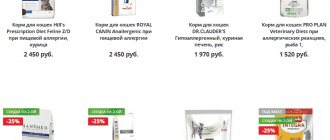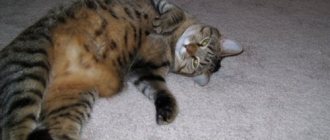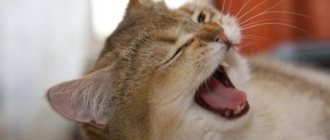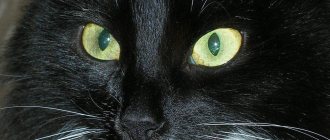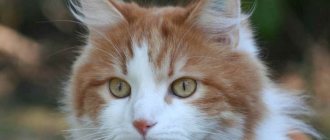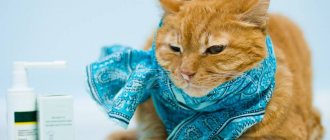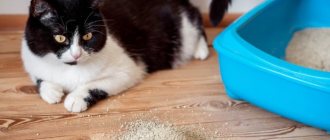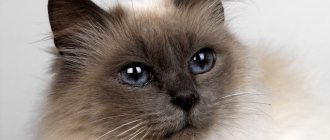Causes of sores on a cat's nose
Diseases of the respiratory system are one of the most common reasons why cat breeders turn to specialists.
The main causes of sores on a cat’s nose:
- viral, parasitic, bacterial, fungal infections;
- injuries, bruises, mechanical damage to the mucous membrane of the nasal passages, nose;
- respiratory, colds of various etiogenesis;
- eye diseases;
- dental problems;
- lack of hygiene, improper care of the nasal cavity;
- decreased immunity, resistance;
- lack of routine vaccinations;
- contact with infected, sick individuals;
- dermatological diseases, pathologies;
- poor living conditions;
- allergic, inflammatory processes in the body.
The cause of nasal sores in cats can be autoimmune diseases, foreign objects in the respiratory tract, benign or malignant formations (polyps), prolonged hypothermia of the body.
Sores on the nose are noted in cats suffering from chronic rhinitis, rhinotracheitis, and conjunctivitis. They can develop against the background of calcivirosis, panleukopenia, chlamydia, herpes virus infection, and other viral and bacterial infections.
Why do wounds occur?
Most often, the formation of ulcers and crusts on the nose is promoted by ailments, such as:
- calicivirus;
- fungi;
- bordetellosis.
Calicivirus
When an animal is infected with such a virus, it may develop conjunctivitis.
It is caused by the Feline calicivirus virus. Infection occurs through contact with a sick animal through saliva, nasal moisture, tears, or when a healthy animal uses bowls and a tray of an infected animal. A cat can also inhale the virus. Manifestation:
- the appearance of wounds on the mucous membranes of the nose and mouth;
- refusal to eat;
- temperature increase;
- dyspnea;
- conjunctivitis;
- lameness due to inflammation of the joints.
Fungal infections
The causative agents are the fungi cryptococcosis, actinomycosis, and Candida. Routes of infection include contact with a sick animal, long-term use of antibiotics, and decreased immunity. Cats that come into contact with soil and birds can also become infected. The fungus can affect not only mucous membranes, but also appear on the pads of the paws, between the toes, and spread to the stomach and genitals. Symptoms:
- bloody discharge from the nose that forms crusts;
- cough, sneezing;
- temperature increase;
- the appearance of a whitish coating or scales on the respiratory system or in the mouth;
- general deterioration of condition.
Bordetellosis
This disease is characterized by the appearance of a cough in the pet.
The disease is caused by Bordetella bacteria, and the disease itself can be transmitted from animals to humans. Cats get sick through contact with saliva, moisture from the nose, sneezing of a bacteria carrier, and also by eating food from the bowl of a sick animal. Signs:
- discharge from the eyes and nose, at the site of which cracks and sores appear;
- decreased appetite;
- hyperemia;
- difficulty breathing;
- cough;
- enlarged lymph nodes.
Allergic reaction
It occurs as a response of the cat’s immune system to an allergen. These include cleaning products, indoor mold, dust, and medications. The cause of an allergic reaction can be food additives if the owner treats the pet with smoked or canned foods that are not intended for animals. Symptoms:
- crack or wound on the lips, nose, bald patches near the ears;
- redness of the ears and skin;
- hair loss, bald patches;
- severe itching of the affected areas;
- worry and anxiety.
Polypous formations
The presence of such formations in the nose forces the animal to shake its head frequently.
They are benign pedunculated growths that form on the nasal mucosa. They occur mainly against the background of chronic diseases of the nasopharynx - otitis media, rhinitis or due to impaired tissue development. Polyps can spread to the structures of the middle ear. Due to impaired nasal breathing, the cat rubs its nose, which causes a sore. In addition, the following signs indicate polyps:
- sniffling and wheezing;
- difficulty swallowing and breathing;
- change in voice timbre;
- frequent shaking of the head;
- impaired coordination of movements if the polyp has grown into the ear;
- weight loss due to difficulty eating because the nose is not breathing.
Bruises and wounds
Violation of the integrity of the nasal covering occurs as a result of a cat falling from a height, an accidental blow to a heavy object, or after a fight with relatives. Injuries provoke nosebleeds, so the damaged area becomes covered with a crust. The condition is manifested by the animal's restlessness, temporary aggression due to pain, snorting, and sneezing. However, bruises and wounds can be combined with serious head injuries. Therefore, you should consult a doctor if your cat develops the following symptoms:
The animal should be taken to the veterinarian if the injury is combined with a convulsive syndrome.
- impaired coordination of movements;
- vomit;
- nosebleeds that won't stop;
- convulsions;
- loss of consciousness.
Injuries, bruises of the nose
Mechanical damage to the nasal cavity often leads to nosebleeds, the formation of dark brown, gray, black crusts on the lobe, on the sides of the nostrils, the appearance of ulcers, wounds (erosive manifestations), through which infection can enter the body.
A severe bruise of the nose can provoke deformation of the nasal passages, nasal congestion, swelling, hyperemia of the mucous membrane and lobe.
Important! Dark dry crusts are formed due to injury and skin damage. Cause discomfort in animals and interfere with normal breathing.
Note that crusts on the nose can also appear due to rhinitis, inflammatory processes in the nasal cavity, nasopharynx, bronchi, respiratory infections, viral, fungal, and bacterial diseases.
Disease Prevention
All this can be avoided if you follow simple rules of prevention:
- regularly examine your cat for wounds and abrasions and treat them promptly;
- carry out routine vaccination against many viral and bacterial diseases and dermatitis;
- do not let your domestic cat go for walks alone and monitor him regularly;
- monitor the hygiene of the animal not only in appearance, but also in the oral, ear and nasal cavities.
Important! You should not self-medicate or get carried away with folk or homeopathic remedies. It is recommended to contact a qualified specialist as quickly as possible if the disease has already occurred.
If a kitten develops black crusts near its nose, then there is no need to hesitate, because they can begin to fester and shed blood. Sores can form as a result of various diseases, some of which are deadly.
Types of sores on a cat's nose
Sores that appear on a cat’s nose in the nasal passages can be very different.
Most often in veterinary practice, cats are diagnosed with:
- ulcerative-erosive lesions of the lobe, mucous membranes of the nasal passages;
- black dots, age spots;
- crusts, scabs on the nose;
- pathological growths, ulcers;
- nasal deformity;
- bumps, cysts on the nose;
- pathological pigmentation;
- suppuration of the nose;
- swelling of the nose, nasal passages;
- growths on the mucous membrane of the nasal passages;
- dry, cracked nose.
How to treat ulcers on the nose?
Surgical intervention
Surgery is required for polypous growths. A ventral Bull osteotomy is performed, in which the lower part of the middle ear bone is excised and the polyp is removed. The polyp is also pulled out, causing it to tear away from the stalk. However, this method is dangerous for the development of relapses.
Drug therapy
Liniments should be applied to the nose while the cat is sleeping, otherwise she will lick the medicine, which will cause bowel upset.
All medications are prescribed by a veterinarian; self-medication is unacceptable. Minor scratches on the nose heal on their own. If suppuration occurs, it is recommended to lubricate the organ with Levomekol liniment. It is recommended to treat the crusts with a decoction of chamomile, calendula, and oak bark. For infectious diseases, depending on the etiology, the drugs shown in the table are prescribed:
| Drug group | Medication |
| Antibiotics | "Enroxil" |
| "Clavaseptin" | |
| Bayer Baytril | |
| "Zoetis Synulox" | |
| "Veraflox" | |
| Antifungal | "Ketoconazole" |
| "Clotrimazole" | |
| Potassium iodide | |
| Saline solutions | Sodium chloride |
| "Ringera" | |
| Glucose | |
| Immunostimulants | Any vitamin and mineral complexes for cats |
| "Gamavit" | |
| Antibacterial lotions for treating sores on the nose | "Divopride" |
Treatment
Treatment of nasal sores is prescribed by a veterinarian for cats on an individual basis. The age, physiological characteristics, general condition of the animal, diagnosis, and the cause of nasal pathology are taken into account.
In treatment, general remedies are used, preparations in the form of drops, ointments, solutions, sprays for local treatment, rinsing the nose, nasal passages. Cats are prescribed antibiotics, antiseptics, painkillers, anti-inflammatory, antihistamines, and antifungal drugs.
Homeopathy, physiotherapy, and alternative medicine are used as additional treatment.
After treatment, we recommend taking the cat to the clinic for re-diagnosis and testing, since some diseases can fade and appear as relapses over time.
When is it necessary to consult a veterinarian?
In most cases, dermatological diseases in cats are treated at home and do not pose a threat to life. However, there are situations in which mandatory veterinary assistance is required. Sometimes self-treatment of a pet can lead to serious and even tragic consequences. Reasons for visiting a veterinary clinic should be:
- increase in pet's body temperature;
- decreased motor activity and lack of response to external stimuli for a long time (more than 24 hours);
- refusal of food and water;
- inability to rise independently;
- bleeding;
- uncontrollable vomiting;
- diarrhea;
- suppuration in the eye area;
- impaired respiratory function (urgent treatment measures are required if the pet is breathing heavily and wheezing or if its breathing is rapid and shallow);
- blood in urine or stool;
- a plaintive meow for no apparent reason.
